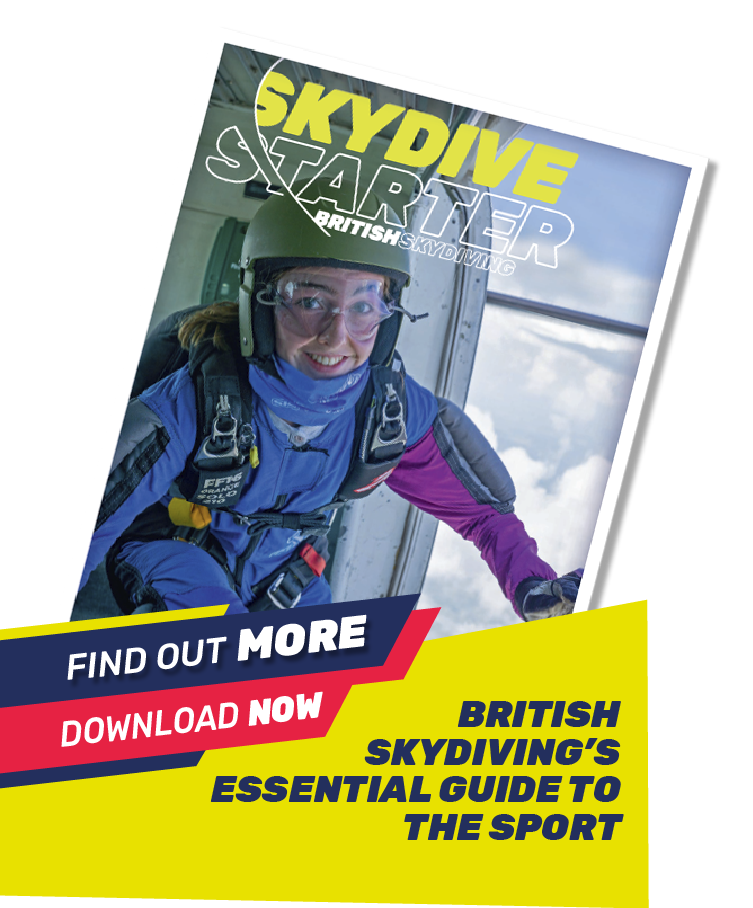Learn to Skydive
ACCELERATED FREE FALL (AFF)
Accelerated Free Fall (AFF)
AFF is an intensive course, more expensive but allowing rapid progression in skydiving. Your first descent is from 12,000 feet accompanied by two highly specialised instructors who will guide you in freefall by way of hand signals and under canopy with radio communication. You will experience 40-45 seconds of freefall before you open your own, ram-air canopy at 5,000 feet. This is the real sport!
Your first AFF jump is part of a week’s course of 8 levels and a minimum of 10 consolidation jumps which will qualify you as a skydiver in your own right. If you know you want to take up skydiving, this is probably the quickest and most motivating method by which to do it.
Once qualified you can move on to learn the skills required to jump with your friends and to learn new disciplines.
AFF Progression System
AFF is an intensive course, more expensive but allowing rapid progression in skydiving. Your first descent is from 12,000 feet accompanied by two highly specialised instructors who will guide you in freefall by way of hand signals and under canopy with radio communication. You will experience 40-45 seconds of freefall before you open your own, ram-air canopy at 5,000 feet. This is the real sport!
Your first AFF jump is part of a week’s course of 8 levels and a minimum of 10 consolidation jumps which will qualify you as a skydiver in your own right. If you know you want to take up skydiving, this is probably the quickest and most motivating method by which to do it.
Once qualified you can move on to learn the skills required to jump with your friends and to learn new disciplines.
STATIC LINE
Static Line
A static line descent can be made after usually about 6 hours of ground training and involves the student jumper leaving the aircraft at around 4,000 feet. The main parachute is deployed using a device called a ‘static line’. This is a length of webbing attached to the aircraft at one end and the bag, in which the main parachute is kept, at the other, as the jumper falls away from the aircraft, the static line pulls the main parachute out and begins the deployment.
The parachute or canopy used is a modern ‘square parachute’ made of technically advanced materials and specifically designed to allow the student jumper to steer the canopy to the landing area. A radio attached to the jumper’s helmet is often used to coach the student and assist in the landing of the parachute.
This type of jump opens the way to becoming a skydiver, further training and more descents will allow the student to skydive without the static line, deploying the parachute manually and achieving that all-important ‘first free fall’ descent.
Static Line Progression System
The Progression System will take you step by step through student status to Category 8, when you qualify as a certified skydiver and are cleared to jump on your own or with a coach.
The system has a series of 8 levels that teach the all the skills you need to obtain your British Skydiving A Licence.
After passing your Canopy Training written exam, you will be eligible for your British Skydiving A Licence and can start learning how to develop your skills in a chosen area, such as formation skydiving or freeflying.
The Static Line Progression System is ideal if you want ‘Pay as You Go’ with each jump.
RISE TO A NEW CHALLENGE!
Want to take the next step and begin your journey to new heights?
There are 26 affiliated Parachute Training Organisations in the UK for you to choose from. All of them follow the same safety standards so wherever you jump and whatever training method you choose, you can rest assured that an exhilarating experience awaits.

British Skydiving is committed to maintaining the highest standards of safety in the sport. British Skydiving’s approach to safety management is established as good practice in the sport.
Restrictions
Acceptance for parachute training is entirely at the discretion of the individual Parachute Training Organisation. For full information, please contact your chosen Affiliated Parachute Training Organisation.


